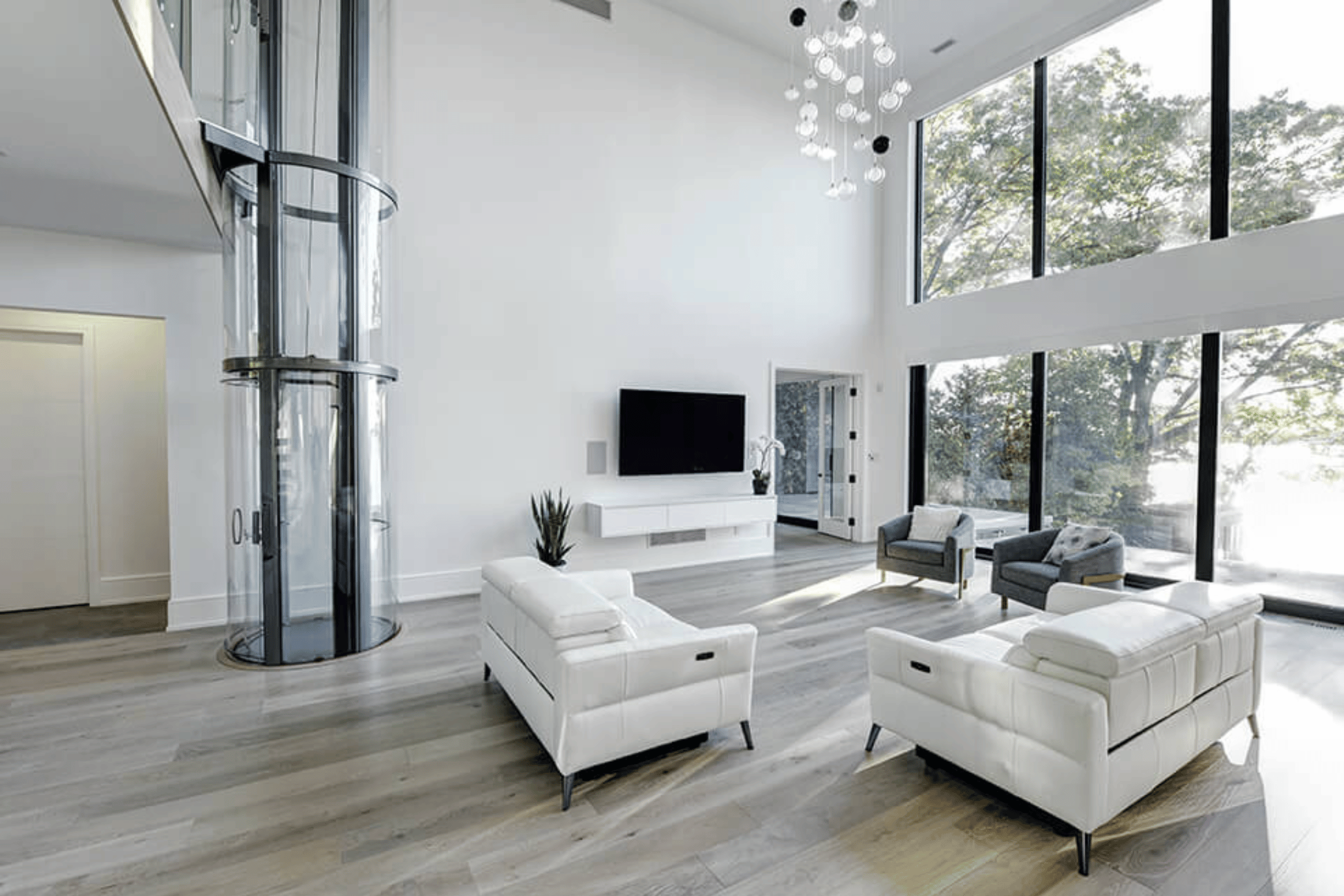Lifestyle and Living
Graceful Aging in Place: Stylish & Sustainable Home Design
Nov 2023 | By Christine Brown
What is Aging in Place?
The Canada National Housing agency, CMHC, defines aging in place as the ability to live in the same home or community safely, independently, and comfortably, as you age. Staying in our homes as we age is a desire many of us share and it’s possible to have a functional home without sacrificing style and sustainability! By making thoughtful choices about sustainable materials and smart design, you can create a living space that is not only safe and comfortable but beautiful and environmentally friendly.
So, Where Do I Start?
There are number of Aging in Place guides and checklists to help you develop a plan that considers aging-in-place principles when building or renovating your home. From the exterior of your home to the heart of the home, from stairlifts to glass elevators, these comprehensive checklists ensure you can easily incorporate aesthetic design elements that meet your needs, while ensuring your home remains safe and comfortable for years to come. This article will touch on a few of the recommendations for your home and dive a little deeper into the kitchen and bathroom design. Oh, I do love kitchen and bathroom updates!
I have listed resources and included tips and recommendations to help you plan for loving life in your home, long term! You may also choose to hire a Canadian – Certified Aging in Place Specialist to plan for your specific needs.
No Cost to Low Cost – There’s More than Just a Grab Bar!
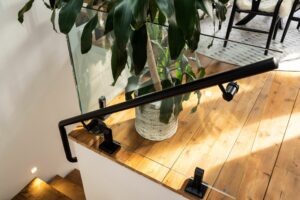
When we think of home modifications for aging in place, we automatically think of the grab bar, however, there is so much more! Subtle design choices and modifications can have a significant impact on how long you can comfortably live in your home, without compromising style and sustainability. For example, CMHC and the March of Dimes developed a comprehensive guide for Low-cost and No-cost Home Modifications that you can incorporate right now, such as added energy efficient LED lighting that require fewer light bulb changes, and timers to turn lights on and off for comfort an safety.
Throughout Your Home
Industry experts recommendations you can include throughout your home:
- Add hand grips to doorknobs or replacing knobs with door levers.
- Install easy to grip D-type pulls on drawers and cabinets.
- Remove area rugs when vision is impaired and keep floors smooth and level to remove tripping hazards.
- Consistent flooring throughout eliminating or reducing transitions and thresholds.
- Removing clutter and obstacles, opening spaces throughout your home
- Open floor plans with wide doorways and hallways ensure easy mobility and accessibility, allowing for freedom of movement.
- Maximize the use of natural light through strategically placed windows and skylights. This reduces the need for artificial lighting and enhances the space.
- Ensure well-lighted areas. Consider using wireless, motion sensor lighting or touch lights. Include indirect lighting to reduce glare and shadows that may create tripping hazards.
- Replace toggle light switches with a rocker panel.
- Use colour to define space for improved depth perception. A low VOC paint is an eco-friendly option.
Kitchens – The Heart of the Home
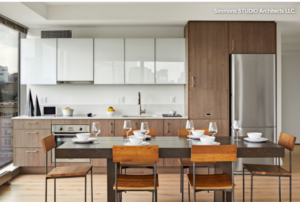 Whether you are preparing to build new or renovate your existing kitchen or bathroom, there are many details to consider. Industry experts have developed useful design guides and checklists such as The National Association of Home Builders Aging in Place Design checklist. Here are some recommendations for the kitchen:
Whether you are preparing to build new or renovate your existing kitchen or bathroom, there are many details to consider. Industry experts have developed useful design guides and checklists such as The National Association of Home Builders Aging in Place Design checklist. Here are some recommendations for the kitchen:
- Adjustable and/or varied height counters.
- Removable base cabinets for space to accommodate a wheelchair.
- Upper wall cabinetry three inches lower than conventional height.
- Counter space for dish landing adjacent to or opposite all appliances.
- Base cabinets with roll out trays, pull out pantry and lazy Susan’s for easy access to all your goods.
- Use pullout cabinets to store heavy portable appliances, such as blenders, slow cookers, and toasters.
- Glass-front cabinet doors to see all your beautiful dishes!
- Open shelving for easy access to frequently used items, like the cookie jar or wine rack!
- Microwave oven at counter height or in wall to minimize bending and reaching over your shoulders.
- Side-swing or wall oven.
- Clearance around cabinets and island should be 42”- 46” and doorways leading to the kitchen should be at least 36” wide.
- Consider an island on wheels, adjusting to provide clearance for a walker or wheelchair.
Next Up! Your Bathroom Oasis
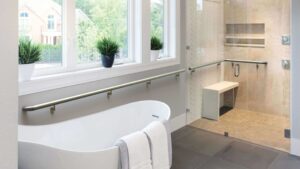 Here are a few of the recommendations for building new or renovating your bathroom: Note to self, grab bars and handrails don’t have to be institutional and hideous!
Here are a few of the recommendations for building new or renovating your bathroom: Note to self, grab bars and handrails don’t have to be institutional and hideous!
- Adjustable and/or varied height counters and removable base cabinets.
- At least one wheelchair maneuverable bath on main level with 60-inch turning radius or acceptable T-turn space and 36-inch by 36-inch or 30-inch by 48-inch clear space.
- Bracing in walls around tub, shower, shower seat, and toilet for installation of grab bars to support 250-300 pounds.
- Stand-up shower – curbless and minimum of 36-inches wide.
- Bathtub – lower for easier access
- Seat in shower or fold down seat in the shower
- Adjustable/handheld showerheads, 6-foot hose
- Light in shower stall
- Toilet two and half inches higher than standard toilet (17-19 inches) or height-adjustable
- Slip-resistant flooring in bathroom and shower
Elevate your Design with Style and Sustainability!
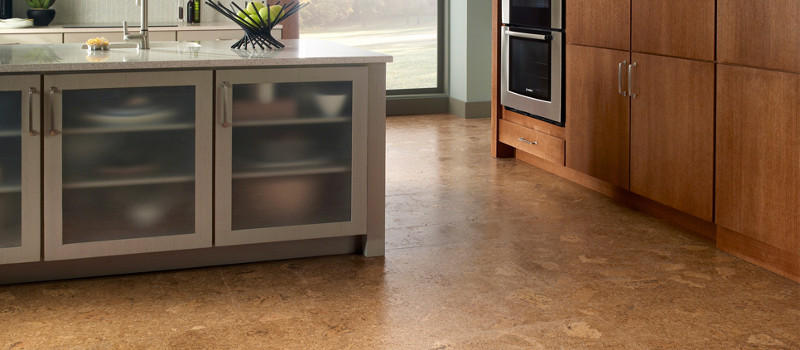
Now let’s turn our attention to the materials needed to complete your beautiful, and sustainable design. We will start with flooring.
Flooring:
There is nothing more environmentally friendly than reusing or repurposing what you have. You may love your existing tile or stone floor but find it slippery. Rather than replacing, you can apply a texture to it to prevent slipping. Should you decide to replace the flooring, there are many eco-friendly flooring options. For example, sustainable flooring options such as bamboo or cork are both beautiful and long lasting. Additionally, cork is a softer surface and easier on the joints.
Real linoleum—”as distinct from synthetic versions or vinyl—is made from all-natural materials, including wood flour, rosins, ground limestone, powdered cork, pigments, jute, and linseed oil.” One of the greenest flooring options, it has natural mineral pigments, offering wonderful colours and patterns. According to the David Suzuki Foundation, a similar product, marmoleum, also has no volatile organic compound (VOC) emissions. “Its performance gets better with time because it hardens when exposed to air, increasing durability.”
Should you decide that tile still makes your heart sing, select smaller tiles, less distance between tiles will prevent slipping. Some of the sustainable countertop producers also offer a selection of floor tiles. Let’s move on to the jewel of the kitchen – the countertops!
Countertops:
With so many fabulous options, countertops are one of the most exciting design elements you will choose for your kitchen and bathroom. There is a wide range of sustainable countertop options made from materials that are eco-friendly, recycled, or have low environmental impact. Ranging from recycled glass, recycled paper, and resin to bamboo, they are low on environmental impact but high on style! If possible, choose locally sourced or manufactured materials to reduce transportation emissions. And of course, choosing long-lasting materials will reduce the need for replacement saving money and trips to the landfill!
Lastly, Be sure to do your research, look for certifications such as FSC- certified, GREENGUARD Environmental Institute, ISO 14001, and Cradle-to-Cradle certified, and companies that promote and adhere to strong social and environmental policies. Greencoast.org and One Community Global.org have pulled together eco-friendly countertops and flooring brands to help you get started.
Creating a home that supports aging in place with enhanced comfort and functionality while honouring your commitment to the environment requires thoughtful choices and is truly a labour of love. There is far more to discuss on this topic, but I hope the information in this article and the resources noted below will help you develop your plan for living and thriving in your beloved home. L. Frank Baum summed it up… “There is no place like home.”
Christine Brown
Hello@bobbiebroon.ca
Christine is the founder of Bobbie Broon Home, a home design and décor business offering sustainable and ethically produced home and lifestyle products. A Project Manager, Christine is an accredited member of the Decorators & Designers Association of Canada.
Additional Resources
The Council on Aging of Ottawa Aging in Place with Home Modifications
Aging in Place Design Checklist- the Living in Place Institute
United Way Aging in Place Toolkit
NHBA Aging-In-Place Remodeling Checklist
March of Dimes Low-Cost and No-Cost Home Modifications for Seniors and People with a Disability
Architectural Digest Everything You Should Know About Designing a Home for Aging in Place
David Suzuki Foundation Green your next home renovation

